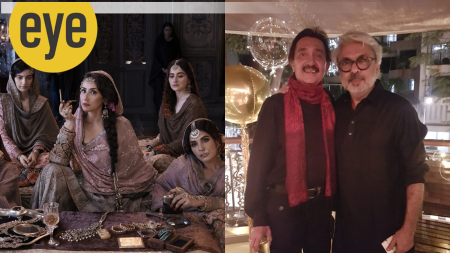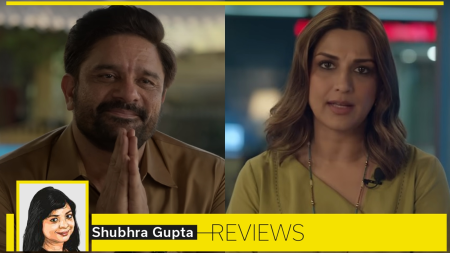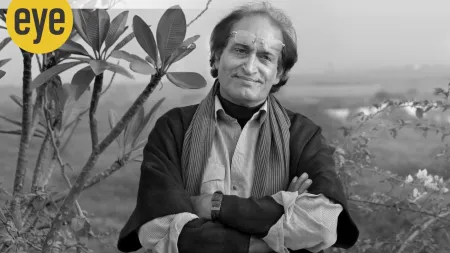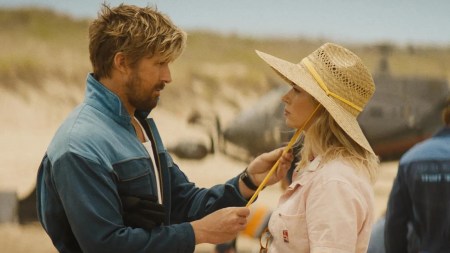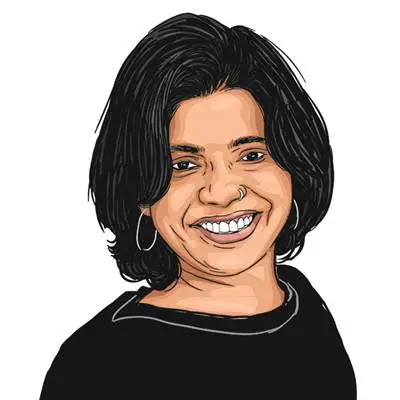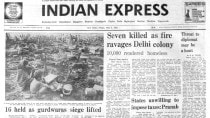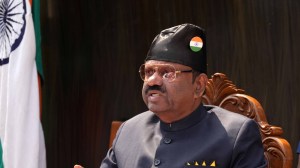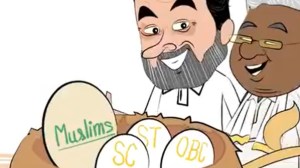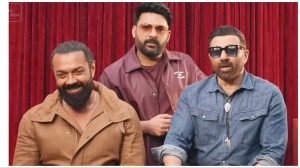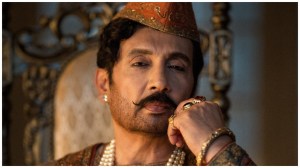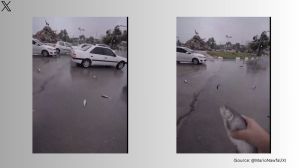- India
- International
The old Parliament building: Notes from a Parliament reporter’s diary
Liz Mathew writes: Old Parliament building is filled with memories of political jousts, wit and warmth. Will they find their way into the new Parliament building?
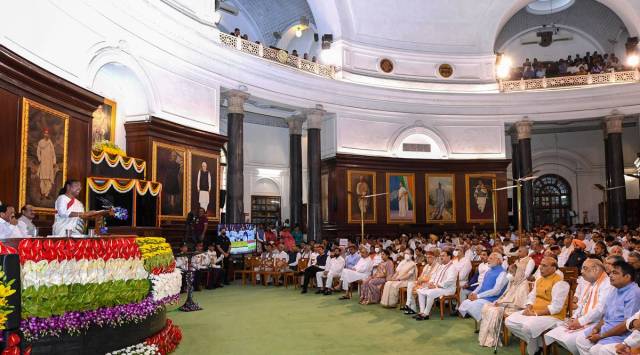 President Droupadi Murmu during her swearing-in-ceremony, in the Central Hall of Parliament, in New Delhi, Monday, July 25, 2022. (PTI Photo)
President Droupadi Murmu during her swearing-in-ceremony, in the Central Hall of Parliament, in New Delhi, Monday, July 25, 2022. (PTI Photo)Editor’s note: This piece was published originally on August 9, 2022. It has been written by Liz Matthew.
Yesterday as the Monsoon Session concluded, a sombre mood dawned on me as I walked out of Parliament House. If the powers that be are to be believed, this session – as stormy as several others in the recent past — will be the last to be held in this magnificent building, built 100 years ago. The Winter Session in November-December is expected to be held in the new building, which is coming up at a rapid rate, and fast overshadowing the majestic structure designed by Edwin Lutyens and Herbert Baker. But nothing can erase the history created in this building.
I began my career in journalism in Delhi, literally growing up professionally in this building. Like the 144 pillars in this marvellous piece of architecture, I too witnessed the major political events of the last 25 years in its confines. (The only big event I missed was the 2001 terror attack which happened when I was out of Delhi.)
As I walked out of the building, I was filled with mixed feelings about the new building. Many share my sentiments. The question that is weighing heavily on everyone’s mind is: Will the atmosphere of the Central Hall, the focal point of many a churning in national politics, be replicated in the new building? Some say that in its place there could be a frugal lounge that could deprive members, their immediate families, senior politicians, including chief ministers who visit Delhi, and senior journalists of the convivial atmosphere that was the signature of the Central Hall.
The BJP in its current avatar does not seem to have an emotional connection with the Central Hall — senior cabinet members rarely visit it. In the past, even prime ministers used to spend time there. This change in political culture, exacerbated by the pandemic and its restrictions, has diminished the ethos and activities of Parliament: The duration of sessions has reduced, and the fourth estate has become almost invisible. The Central Hall is a “no entry zone” not just for journalists but for former MPs as well. Senior journalists now get nostalgic about spending hours with politicians, often sipping hot coffee or soup in the Central Hall, where the fans are installed upside down.

I came to Delhi when national politics was undergoing a churning of sorts. The aristocratic politician was giving way to the leader from the grass roots. Speeches in clipped English were being replaced with oratory in Hindi dialects from mofussil centres. But Parliament still brimmed with warmth and camaraderie. The veterans had accepted the leaders emerging from Mandal and Mandir politics.
Despite the intense schisms, one could see members from both sides having a friendly chat over snacks from the Coffee Board-run outlet. At least four ideologies were in full play — the Congress trying to retain its foothold, the socialists raising Mandal politics, the Left still steady under a credible leadership and the BJP. This social space shared by different ideologies was later used by Atal Bihari Vajpayee to stitch a rainbow coalition.
As I watched regimes change – from Vajpayee’s 13-day ministry to the uncertain United Front days of H D Deve Gowda and I K Gujral and the relatively stable but eventful decade with Manmohan Singh at the helm of affairs — my experiences at Parliament House also underwent transformations. We used to carry bundles of papers – answers to MPs’ questions, panel reports. Now, a paperless Parliament is becoming a reality.
What I miss the most is the absence of quality debates. I have seen and heard Vajpayee, L K Advani, Madhav Rao Scindia, Rajesh Pilot, Chandrashekhar, Somnath Chatterjee, Indrajit Gupta, S Jaipal Reddy, George Fernandes, Sitaram Yechury… the list is long. The success and the productivity of a Session used to be measured through the quality of debates, not just the hours spent on the bench or bills passed. I could get a sense of the nuances of Indian politics by listening to politicians like Pramod Mahajan, K Karunakaran, Arjun Singh, Pranab Mukherjee and Arun Jaitley. Even the transformation of the BJP into a ruling party was best seen on the floor of the House.
I remember Vajpayee leading a group of 161 BJP MPs as a solitary general — the political isolation that the BJP faced was described as “untouchability” by some leaders. In 1996, he faced the inevitable with dignity. I remember his passionate speech: “If breaking up political parties is the only way to form a coalition that stays in power, then I do not want to touch such a coalition with a barge pole”. He ended by saying, “Adhyaksh mahoday, mein apna tyag patra rashtrapati ko dene jaa raha hun (Respected Speaker, I am now leaving to tender my resignation to the President). With debates going on till late evening, all that would keep us awake was the tea, with a drop of milk, served at Panditji’s tea point.
During Vajpayee’s second stint, the BJP was dependent on the J Jayalalithaa-led AIADMK to stay in office. After 13 months, when Jayalalithaa decided to end the alliance, Vajpayee was unusually peeved. On April 17, 1999, when the screens inside the Lok Sabha showed the tally of the no-confidence motion at 269-270 – he lost the majority by one vote – the House was briefly silent before the Opposition broke into celebrations. But I could sense the sympathy and awe Vajpayee had evoked in many on the other side when he looked at the result and raised his hand to his forehead in a mock salute.
But this Parliament also witnessed the BJP, stunned after losing power in 2004, seemingly in denial about the Congress-led UPA’s rise to power. In the initial sessions, its 138 MPs disrupted proceedings. They created uproarious scenes even when Prime Minister Manmohan Singh introduced his cabinet. The UPA years were the last time Parliament saw the Prime Minister in attendance regularly.
The press gallery has its share of amusements as well. The members speak different languages and wear various outfits – there is no official dress code. Varkkala Radhakrishnan, a former speaker of the Kerala assembly, was a stickler for the rules in the Lower House. He drew tremendous respect from the treasury benches during Vajpayee’s time. Once he berated the (then) Union Minister Dasari Narayan Rao for keeping the top buttons of his shirt open while replying to questions.
Then there’s former Rajya Sabha MP Vakkachan Mattathil, who was amused when Vajpayee told him in one of the restrooms that “you are lucky to use the facilities with the Prime Minister of India.” If Shashi Tharoor is a social media sensation today for his English vocabulary, Jaipal Reddy was the wordsmith for an earlier generation. Reddy – then in the Janata Dal – took exception to the Vajpayee government’s favourable stand in the Supreme Court on allowing puja at the disputed site in Ayodhya. About Vajpayee, he said: “There is a humongous hiatus, a gigantic gap and a gargantuan gulf between his public image and private reality.”
The changes after liberalisation were reflected inside the Parliament complex. From a time when very few MPs had cars — Ambassadors or Fiats — a plethora of imported vehicles now lays siege to the complex.
Today, there is a widening gulf between political parties. The convention – honoured by all political parties — was that the Rajya Sabha would go ahead with debates even if there is conflict or pandemonium in the Lok Sabha.
But this Monsoon session – presumably the last in this building — was almost a washout!
I have spent more time in this building than at my home in Kerala. The friendships I made in the corridors of power endure. Many of the staff in the building have seen me coming to Parliament since my early 20s — switching jobs, getting married and now as the mother of the twin girls who are grown up now. This Parliament House has been a constant figure in my life over the last 25 years. I do not know if the old sense of warmth will find its way to the new building.
Write to the author at liz.mathew@expressindia.com
EXPRESS OPINION
More Explained
May 05: Latest News
- 01
- 02
- 03
- 04
- 05


